Adrian's Research Page !Under Construction!
Recent and Ongoing Research Projects
My colleagues:
|
ANU: Christoph Arns, Holger Averdunk, Mark Knackstedt, Vanessa Robins, Arthur Sakellariou, Rob Sok, Paul Veldkamp Uni. New South Wales: Viet Nguyen, W. Val Pinczewski Uni. Erlangen: Klaus Mecke, Boris Breidenbach |
| |
||
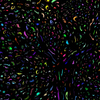
|
Parallel Algorithms for Morphological Image Analysis.
Not yet published Many tasks in morphological image analysis involve region growing and searching - depth first, breadth first, or ordered by some function. Examples of such tasks are the fast marching method of Sethian, the distance-ordered medial axis transform and various watershed transforms. These algorithms are inherently sequential and inherently local, in that it is necessary and sufficient to know the history of a voxel's neighbourhood at all times. The time warp method, used for discrete event simulation, is ideal for parallelising these algorithms. We have implemented a framework for doing this using MPI (the message passing interface), which scales effectively to hundreds of CPUs. |
|
| |
||
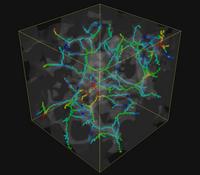
|
Using Topological Persistence and Simplification for 3D Image Analysis
(Vanessa and Klaus)
Ongoing project, recipient of ARC Discovery Project funding 2006-2009 Edelsbrunner, Zomorodian and others have introduced a very interesting method for the simplification of a simplicial complex - usually a geometric mesh - by reordering the elements in the filtration of the complex. We are applying their ideas to the segmentation and morphological analysis of large 3D images. |
|
| |
||

|
Mango: Parallel Toolkit for 3D Image Analysis
(Rob, Holger, Paul, Boris and others)
Software development project While an increasing range of tools are available for the analysis of three dimensional images, Mango is unique in being designed from the ground up for operation on a distributed-memory parallel architecture. It contains a wide variety of sophisticated algorithms for image segmentation and morphological analysis, all of which are scalable and can run in parallel, enabling the analysis of extremely large data sets. |
|
| |
||
|
Dynamic tomography
(Arthur)
Planned project Making 3D movies with an X-ray CT facility can be a laborious process if each frame is captured as an independent image. It is, however, frequently possible to build frames from very incomplete scanning data, which contain only the changes from a preceding image. This technique can be very powerful if the changes are sufficiently slow or can be controlled. |
||
| |
||
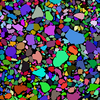
|
Partitioning Complex Objects
SCA 2005 /2006 A powerful method for understanding complex objects is to partition them into networks of simple building blocks. It is then possible to study the distrinbution of building block shape and size, and apply complex network analysis to the connectivity of the entire object. We use watershed methods in our partitionings at the moment, but they are limited to rather isotropic (read "sphere-like") objects. |
|
| |
||
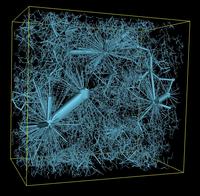
|
Generation of Representative Pore Networks
(Mark, Rob, Holger and Val)
SCA 2005 paper An excellent way to make sense of a complex object - in this case the pore space of a porous material - is to reduce the object to a skeleton graph, and then to associate geometrical properties to the edges and vertices of the graph. One is then free to study the geometry of the microscopic elements and the connectivity of the entire feature. There is no single best representative network, and it is key to have good measures for quantifying just how representative is the resultant net. |
|
| |
||
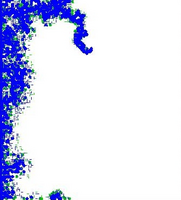
|
Dynamic models for Studying Imbibition in Porous Media
(Viet, Val and Mark)
SCA, SPWLA papers Ongoing project, recipient of ARC Discovery Project funding 2005-2008 We have made a significant improvement to network models by incorporating, implicity, the nonlinear diffusive flow which occurs in wetting menisci in advance of the film front. The diffusive flow is introduced in a completely physical manner by taking advantage of local capillary equilibrium, and is coupled to the frontal advance which is assumed to be inviscid and is modelled using a quasi-static percolation-based approach. The new model allows us to study rate effects in imbibition for the first time, and see the effect of pre-frontal displacements occuring at a finite rane. Results of this method show how the sensitivity to pore shape, pore/throat aspect ratio and wettability. |
|
| |
||
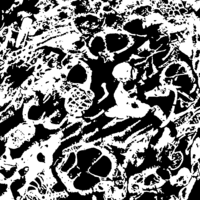
|
3D Image Segmentation
(Rob and Holger)
Physica A paper I need to publish more details of this algorithm. We have evaluated a number of different segmentation methods for the purposes of identifying materials with differing X-ray attenuation within a tomographic image. We find it critical to use a method which uses both value and gradient information, and which is computational efficient enough to be used on very large 3D images. Our preferred approach seeds all regions through a simple thresholding procedure, then grows these regions a variable speed until the boundaries converge and all space is partitioned. By using fast marching type methods to advance region boundaries, numerical stability and efficiency is assured. The algorithm has been parallelised using a time warp framework and is routinely used within the group for large images. |
|
| |
||

|
Efficient Computation of the Covering Radius Transform
(Christoph)
Manuscript in preparation The covering radius transform (CRT) of an object |